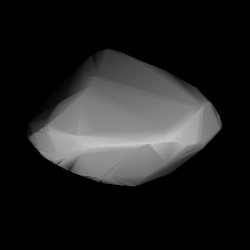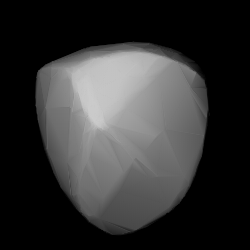Related Research Articles
1509 Esclangona, provisional designation 1938 YG, is a rare-type Hungaria asteroid and binary system from the inner regions of the asteroid belt, approximately 8 kilometers in diameter. It is named after French astronomer Ernest Esclangon.

802 Epyaxa, provisional designation 1915 WR, is a stony Florian asteroid from the inner regions of the asteroid belt, approximately 7.5 kilometers in diameter. It was discovered by German astronomer Max Wolf at the Heidelberg Observatory in southern Germany, on 20 March 1915.
1019 Strackea, provisional designation 1924 QN, is a stony Hungaria asteroid of the inner asteroid belt, approximately 8 kilometers in diameter. It was discovered on 3 March 1924, by astronomer Karl Reinmuth at Heidelberg Observatory in southwest Germany. It is named for German astronomer Gustav Stracke.
5806 Archieroy, provisional designation 1986 AG1, is a stony Hungaria asteroid from the inner regions of the asteroid belt, approximately 6 kilometers in diameter. It was discovered on 11 January 1986, by American astronomer Edward Bowell at Lowell's Anderson Mesa Station near Flagstaff, Arizona. It is named after Scottish astrophysicist Archie Roy.
1453 Fennia, provisional designation 1938 ED1, is a stony Hungaria asteroid and synchronous binary system from the innermost regions of the asteroid belt, approximately 7 kilometers in diameter. Discovered by Yrjö Väisälä at the Turku Observatory in 1938, the asteroid was later named after the Nordic country of Finland. The system's minor-planet moon was discovered in 2007. It has a derived diameter of 1.95 kilometers and is orbiting its primary every 23.55 hours.
3854 George, provisional designation: 1983 EA, is a stony Hungaria asteroid and Mars-crosser from the innermost regions of the asteroid belt, approximately 3.5 kilometers in diameter. It was discovered on 13 March 1983, by American astronomer couple Carolyn and Eugene Shoemaker at the Palomar Observatory in California. The unlikely synchronous binary system has a rotation period of 3.3 hours. It was named after the discoverer's father-in-law, George Shoemaker.
1177 Gonnessia, provisional designation 1930 WA, is a dark background asteroid from the outer regions of the asteroid belt, approximately 99 kilometers in diameter. It was discovered on 24 November 1930, by French astronomer Louis Boyer at the Algiers Observatory in Algeria, North Africa, and named after astronomer François Gonnessiat.
7187 Isobe, provisional designation 1992 BW, is a likely binary Hungaria asteroid from the inner regions of the asteroid belt, approximately 5 kilometers in diameter. It was discovered on 30 January 1992, by American astronomer Eleanor Helin at Palomar Observatory in California, United States. It is named after Japanese astronomer Syuzo Isobe.
1176 Lucidor, provisional designation 1930 VE, is a carbonaceous background asteroid from the central region of the asteroid belt, approximately 30 kilometers in diameter. It was discovered by Eugène Delporte in 1930, who named it after a friend.

2204 Lyyli is a dark asteroid and very eccentric Mars-crosser from the middle region of the asteroid belt, approximately 25 kilometers in diameter. It was discovered on 3 March 1943 by Finnish astronomer Yrjö Väisälä at Turku Observatory in Southwest Finland.
4068 Menestheus is a dark Jupiter trojan from the Greek camp, approximately 67 kilometers in diameter. It was discovered on 19 September 1973, by Dutch astronomers Ingrid and Cornelis van Houten at Leiden, on photographic plates taken by Tom Gehrels at the Palomar Observatory in California, United States. The D-type asteroid belongs to the 60 largest Jupiter trojans and has a rotation period of 14.4 hours. It was named after the Athen leader Menestheus from Greek mythology.
1626 Sadeya is a stony Phocaea asteroid and binary system from the inner regions of the asteroid belt, approximately 15 kilometers in diameter. It was discovered on 10 January 1927, by Catalan astronomer Josep Comas i Solà at Fabra Observatory in Barcelona, Spain, and named after the Spanish and American Astronomical Society. The discovery of a companion was announced on 1 December 2020.
2074 Shoemaker, provisional designation 1974 UA, is a stony Hungaria asteroid, Mars-crosser and suspected synchronous binary system from the innermost regions of the asteroid belt, approximately 4 kilometers in diameter. It was discovered on 17 October 1974, by astronomer Eleanor Helin at the Palomar Observatory. She named it after American astronomer Eugene Shoemaker.
For other uses, see Steel (disambiguation).
1266 Tone is a dark background asteroid from the outer regions of the asteroid belt, approximately 80 kilometers in diameter. Discovered by astronomer Okuro Oikawa at the Tokyo Observatory in 1927, it was assigned the provisional designation 1927 BD. The asteroid was later named after the Tone River, one of Japan's largest rivers.

1186 Turnera, provisional designation 1929 PL, is a stony Eoan asteroid from the outer regions of the asteroid belt, approximately 36 kilometers in diameter. It was discovered on 1 August 1929, by South African astronomer Cyril Jackson at the Union Observatory in Johannesburg. The asteroid was later named after British astronomer Herbert Hall Turner.
4142 Dersu-Uzala, provisional designation 1981 KE, is a Hungaria asteroid, sizable Mars-crosser and potentially slow rotator from the innermost region of the asteroid belt, approximately 6 kilometers in diameter. It was discovered by Czech astronomer Zdeňka Vávrová at Kleť Observatory on 28 May 1981. The rare A-type asteroid has a rotation period of 140 hours. It was named after the Siberian trapper and hunter Dersu Uzala.

1600 Vyssotsky, provisional designation 1947 UC, is a rare-type Hungaria asteroid and suspected interloper from the inner regions of the asteroid belt, approximately 7 kilometers in diameter. It was discovered on 22 October 1947, by American astronomer Carl Wirtanen at Lick Observatory in California, United States. It was named after astronomer Alexander Vyssotsky.
(6382) 1988 EL is a stony Hungaria asteroid from the inner regions of the asteroid belt, approximately 5 kilometers in diameter. It was discovered on 14 March 1988, by American astronomer Jeffrey Alu at the U.S. Palomar Observatory, California.
(90075) 2002 VU94 (provisional designation 2002 VU94) is an asteroid on an eccentric orbit, classified as near-Earth object and potentially hazardous asteroid of the Apollo group, approximately 2.5 kilometers in diameter. It was discovered on 13 November 2002, by astronomers of the Near-Earth Asteroid Tracking program at Palomar Observatory in California, United States. It is one of the largest potentially hazardous asteroids known.
References
- 1 2 3 4 5 6 "JPL Small-Body Database Browser: 3873 Roddy (1984 WB)" (2017-05-05 last obs.). Jet Propulsion Laboratory . Retrieved 4 July 2017.
- 1 2 3 Schmadel, Lutz D. (2007). "(3873) Roddy". Dictionary of Minor Planet Names – (3873) Roddy. Springer Berlin Heidelberg. p. 329. doi:10.1007/978-3-540-29925-7_3862. ISBN 978-3-540-00238-3.
- 1 2 3 "3873 Roddy (1984 WB)". Minor Planet Center. Retrieved 25 March 2016.
- 1 2 3 4 5 6 "LCDB Data for (3873) Roddy". Asteroid Lightcurve Database (LCDB). Retrieved 25 May 2016.
- 1 2 3 4 5 Warner, Brian D. (January 2013). "Rounding Up the Unusual Suspects". The Minor Planet Bulletin. 40 (1): 36–42. Bibcode:2013MPBu...40...36W. ISSN 1052-8091. PMID 32455349 . Retrieved 1 March 2016.
- 1 2 3 Nugent, C. R.; Mainzer, A.; Masiero, J.; Bauer, J.; Cutri, R. M.; Grav, T.; et al. (December 2015). "NEOWISE Reactivation Mission Year One: Preliminary Asteroid Diameters and Albedos". The Astrophysical Journal. 814 (2): 13. arXiv: 1509.02522 . Bibcode:2015ApJ...814..117N. doi:10.1088/0004-637X/814/2/117 . Retrieved 5 December 2016.
- 1 2 3 4 Usui, Fumihiko; Kuroda, Daisuke; Müller, Thomas G.; Hasegawa, Sunao; Ishiguro, Masateru; Ootsubo, Takafumi; et al. (October 2011). "Asteroid Catalog Using Akari: AKARI/IRC Mid-Infrared Asteroid Survey". Publications of the Astronomical Society of Japan. 63 (5): 1117–1138. Bibcode:2011PASJ...63.1117U. doi: 10.1093/pasj/63.5.1117 . (online, AcuA catalog p. 153)
- 1 2 Warner, Brian D. (September 2006). "Asteroid lightcurve analysis at the Palmer Divide Observatory - late 2005 and early 2006". The Minor Planet Bulletin. 33 (3): 58–62. Bibcode:2006MPBu...33...58W. ISSN 1052-8091 . Retrieved 1 March 2016.
- 1 2 Klinglesmith, Daniel A. III; Hendrickx, Sebastian; Madden, Karl; Montgomery, Samuel (April 2016). "Lightcurves for Shape/Spin Models". The Minor Planet Bulletin. 43 (2): 123–128. Bibcode:2016MPBu...43..123K. ISSN 1052-8091 . Retrieved 5 December 2016.
- 1 2 Warner, Brian D. (June 2008). "Asteroid Lightcurve Analysis at the Palmer Divide Observatory - June - October 2007". The Minor Planet Bulletin. 35 (2): 56–60. Bibcode:2008MPBu...35...56W. ISSN 1052-8091 . Retrieved 1 March 2016.
- 1 2 Warner, Brian D. (October 2009). "Asteroid Lightcurve Analysis at the Palmer Divide Observatory: 2009 March-June". The Minor Planet Bulletin. 36 (4): 172–176. arXiv: 1203.4336 . Bibcode:2009MPBu...36..172W. doi:10.1016/j.pss.2012.03.009. ISSN 1052-8091 . Retrieved 1 March 2016.
- 1 2 Warner, Brian D. (January 2016). "Asteroid Lightcurve Analysis at CS3-Palmer Divide Station: 2015 June-September". The Minor Planet Bulletin. 43 (1): 57–65. Bibcode:2016MPBu...43...57W. ISSN 1052-8091. PMID 32455368 . Retrieved 1 March 2016.
- 1 2 3 Carry, B.; Solano, E.; Eggl, S.; DeMeo, F. E. (April 2016). "Spectral properties of near-Earth and Mars-crossing asteroids using Sloan photometry". Icarus. 268: 340–354. arXiv: 1601.02087 . Bibcode:2016Icar..268..340C. doi:10.1016/j.icarus.2015.12.047 . Retrieved 5 December 2016.
- ↑ Faure, Gerard; Garrett, Lawrence (October 2009). "Suggested Revised H Values of Selected Asteroids: Report Number 4". The Minor Planet Bulletin. 36 (4): 140–143. Bibcode:2009MPBu...36..140F. ISSN 1052-8091 . Retrieved 1 March 2016.
- ↑ Warner, Brian D. (April 2011). "Asteroid Lightcurve Analysis at the Palmer Divide Observatory: 2010 September-December". The Minor Planet Bulletin. 38 (2): 82–86. Bibcode:2011MPBu...38...82W. ISSN 1052-8091 . Retrieved 1 March 2016.
- ↑ "MPC/MPO/MPS Archive". Minor Planet Center. Retrieved 25 May 2016.